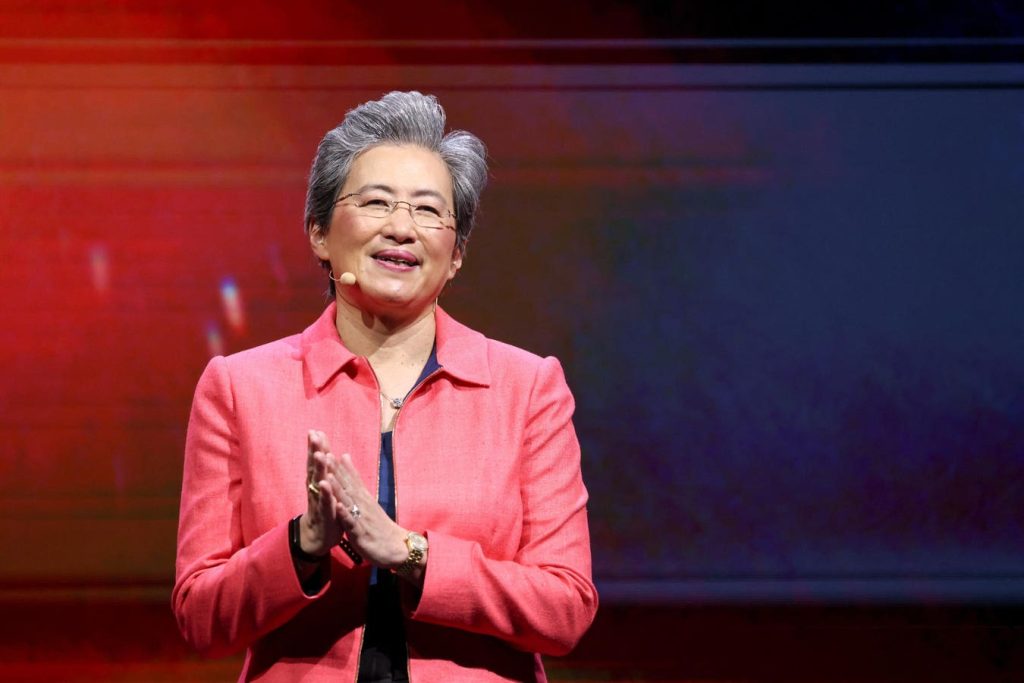At its Advancing AI event in San Francisco a few weeks back, AMD came out with some major announcements for chip designs across its portfolio—datacenter, AI, networking, PC—with the software to back it up. It was a fitting way to celebrate Lisa Su’s 10th anniversary as the company’s CEO, and a reminder of how far AMD has come during that decade.
I can’t remember a time when the semiconductor market was more competitive than this—so AMD, like its competitors, has plenty of challenges ahead of it. My podcasting and business partner Daniel Newman and I interviewed Su on the same day as her big keynote for the event, and she was clearly energized by the opportunities in an era when, she says, “Tech is becoming even more exciting.”
Datacenter CPUs: AMD Continues To Write Its EPYC
It’s fitting to start with CPUs for datacenter servers, because that’s where AMD has been maybe the most impressive over the past few years. As my Moor Insights & Strategy colleague Matt Kimball noted in his technical deep dive on the chips that AMD just announced (fun fact: Matt was the first EPYC product marketing manager), the four previous generations of the EPYC line have seen AMD’s datacenter CPU share grow from less than 2% to 34%. I’ll break down some specifics about its presence in the datacenter in a minute, but it’s worth pausing to reflect on that 17-fold increase in market share in just four generations of a chip family—much of that at the expense of Intel.
The new generation of EPYC, codenamed “Turin,” includes different versions suited for scale-out (cloud) and scale-up (enterprise) workloads. During our interview, Su touted the breadth of fifth-generation EPYC’s appeal, calling it “probably [AMD’s] most comprehensive product portfolio” for the datacenter, and pointing out that the company has optimized socket-level performance for cloud-native environments and the highest performance per core for enterprise environments. She emphasized the latter point in her keynote, explaining that many enterprises pay software licensing fees per core, so cost savings can flow from running apps on fewer cores that are more performant.
How much more performant? Turin handles up to 17% more instructions per cycle than its preceding generation for general-purpose enterprise and cloud workloads, with up to 37% higher IPC for AI and HPC workloads. During her keynote, Su went through a lot of benchmark figures that (predictably) showed EPYC beating Intel Xeon on various performance metrics. She went a step further by noting that this EPYC release comes so soon after the latest Xeon launch that those benchmarks aren’t available—but added that she’s confident the 5th Gen EPYC will still outperform the corresponding Xeon 6 models when they are tested head-to-head. (Note: My company Signal65 did not run these benchmarks.)
Breaking Down AMD’s Datacenter CPU Market Share
Winning in this market has obviously been a major priority for Su and her team over the long haul. During our interview, she said, “The thing that we have found about the datacenter is it’s not just about the product that you launch today. It’s about all the work that we’ve done over the last seven, eight years to build the trust, the capability, the partnerships with the largest cloud hyperscalers.”
That reflects an admirable commitment to long-term development, which has played out in AMD’s absurdly high CPU share among the hyperscalers. AMD’s sweet spot is driving hyperscalers’ internal software, whether consumer or enterprise SaaS. Every time I tell people about the share of business the company has won, I get a double take, but it’s true: AMD has 50% to 60% of hyperscaler CPU share, and with some of the individual customers in that space, it’s as high as 80%.
That’s staggering, but to fully understand the datacenter market, it’s important to balance the hyperscalers against the enterprise side—a very different realm where Intel still reigns. AMD has single-digit share on that side, and the impressive technical performance of EPYC will help it only so much. A lot of the battles for these accounts are won with sales and enterprise marketing. Yes, aging infrastructure in many datacenters could open up more opportunities for head-to-head product comparisons as companies look to replace their servers. But many enterprise customers may be hesitant to press ahead with refresh cycles, and many of them may resist shifting their long-held relationships with Intel. I believe there are a lot of things that AMD could be doing to increase its investment in sales and marketing in this space if it wants to make real inroads against its archrival. I do believe Intel will make a comeback in the first half of 2026, and that AMD needs to gobble up as much share as it can.
AMD’s Approach To Datacenter AI: Instinct MI325X GPU
Getting back to the hyperscalers, at the AMD event Meta disclosed that it runs live inferencing for its 405-billion-parameter Llama 3.1 model exclusively using AMD’s MI300-series GPUs. (On a related note, Meta is running 1.5 million EPYC CPUs overall.) In our interview, Su used the Meta relationship as an example of the collaboration AMD seeks with its customers. “We’ve been working with [Meta] on GPUs for quite some time,” she said, “and we’ve learned how to really co-develop and co-optimize.” That has required lots of effort on the software and on the infrastructure, which makes sense when you consider how specific and finely tuned each hyperscaler’s environment is.
As great as EPYC’s climb has been, the MI300 series is actually the fastest-growing product in AMD’s history. During her keynote, Su explained the company’s revised estimates for the total addressable market for datacenter AI accelerators/GPUs, which she has called “by far the single largest growth opportunity for the industry as well as for AMD.”
As she explained during our interview, “Last year we thought the TAM out through 2027 would be about $400 billion or so, which seemed really large at the time.” But market growth in the past 12 months has led AMD to believe that their numbers were, if anything, too conservative. “Now, as we extend it out through 2028, we think it’s a $500 billion TAM,” Su said. Her keynote slide captured one of the most arresting numbers of the day: that 2028 number implies a CAGR above 60% over a six-year period. In its recent earnings report, the company increased its own 2024 revenue forecast for this segment to $5 billion, which is again staggering, given that it was $0 a little over a year ago.
AMD says that the MI325X, which starts production later this quarter, doubles inference and training performance over the previous generation—and, more importantly, matches or beats Nvidia’s corresponding GPUs, especially in terms of memory capacity and bandwidth. (This will be another fascinating set of benchmarks to see.) During the interview, Su told us, “This market is moving faster than anything that I’ve seen before, and it’s because everybody wants AI to be more fully deployed throughout their enterprises and businesses.” To that end, the MI350 series is coming later in 2025, with the MI400 series on the horizon after that.
In this contest, AMD has its work cut out for it. Nvidia is entrenched at 90% to 95% of the market for GPUs for enterprise AI. AMD holds almost all of the other 5% to 10% of the market, and Intel won’t bring its own competitive datacenter AI GPU, codenamed Falcon Shores, to market until next year. But that still leaves AMD 80 or 90 percentage points behind Nvidia.
Especially once the MI325X and Nvidia’s hot new Blackwell GPUs are both shipping in volume, I want to see if AMD can start to meaningfully chip away at Nvidia’s market share. That won’t come easily, because Nvidia has a huge head of steam and—notwithstanding a couple of recent minor production stumbles—is executing at a high level. AMD doesn’t have AWS or Google Cloud in the MI300 fold-yet, but I do expect AWS to announce that it has signed up at its Reinvent conference next month.
You Can’t Win In Datacenter GPUs Without Good Software: ROCm 6.2
One thing that helps Nvidia retain its dominance is its CUDA software, which ties together its AI chips. I’ve had big-time hardware CEOs tell me point-blank that in some cases they choose one chip vendor over another on the basis of the software rather than the chip. Especially for something as specialized as AI, the software matters a lot.
I know that AMD grasps this because of the effort they’ve put into developing their ROCm software, which has been really good for HPC for a while, but has turned the corner in AI more recently. ROCm 6.2 is a significant contributor to that 2x performance increase in training and inferencing for the MI325X, plus it can now run more than 1 million different AI models out of the box.
It’s clear that this is a topic close to Su’s heart. She said, “If there’s one thing I’m most proud of over the last year, it’s the work that we’ve made on the ROCm software stack and really courting developers to want to optimize to AMD.” This involves a lot of heavy lifting to put the right libraries in place and tune the software, and it’s another example of the dedication to co-development she talked about with Meta. (By the way, both in general and because of its role in the creation of the PyTorch machine-learning library, Meta is a very tough grader in this area. So if AMD is making Meta this happy, I expect it could make any customer happy.)
New Networking Chips To Connect All Those Processors
Not enough attention has been paid to something remarkable AMD did at its big launch event: enter a brand-new market. During the keynote session, Forrest Norrod, who heads AMD’s Data Center Solutions Business Group, introduced the Pensando Salina DPU and the Pensando Pollara 400 NIC. These chips enable the front-end and back-end connections required to deliver the data for AI processing and the output from the datacenter to the wider world.
The Pensando Salina is AMD’s third-generation DPU, which offers many upgrades over its predecessor while enabling critical offload that improves AI and machine learning functions. In short, it is designed to handle data transmission at a level that meets the hyperscalers’ needs. This is an important step up in functionality, but the real breakthrough is the Pensando Pollara 400, which is purpose-built for AI, and which AMD believes will be the first Ultra Ethernet-ready AI NIC on the market. This product could give Broadcom’s 400G Thor NIC a run for its money. Both Pensando devices are sampling now, with volume shipments expected in the first half of 2025. If you’d like to dig into the technical details and more of the context, my colleague Will Townsend has just published a research brief about the two Pensando products.
As with the upgrades to the ROCm software, the launch of these devices shows AMD’s attention to strategic detail. It’s one thing to make a hot processor, but for AMD to take the big slice of the enterprise AI market that it wants, it needs to be as attentive to the technical and business ecosystem as Nvidia and Intel are. With a few exceptions such as its relative weakness in selling into enterprise datacenters, I think it’s doing that.
Enterprise-Quality AI PCs: Ryzen AI PRO 300 Series
It’s a testament to AMD’s huge growth in datacenters that we’ve come this far without mentioning PCs. The third generation of AMD’s commercial AI mobile processors come with NPUs capable of 50-plus TOPS—well above the minimum set by Microsoft for Copilot+ PCs—and promise terrific battery life, too. Aiming squarely at the commercial market, they also support a bunch of enterprise-specific features for security, system recovery, supply chain traceability and more.
That’s before we get to on-device AI features such as live captioning and language translation during conference calls, or image generation. During the keynote, Su was joined onstage by Pavan Davuluri, the top Microsoft executive for Windows+ devices. He ran through a long list of AI-driven productivity and collaboration features built into Microsoft 365 and Windows itself that will run at high speed on AMD’s processors. This includes better on-device search for files, the much-discussed Recall feature and a just-released function called Click To Do. I found it interesting to hear Davuluri talk about the hybrid AI future—Microsoft, the company with a very large datacenter estate also espousing AI on the edge. I believe categorically that this hybrid AI future is going to happen; the only question is when.
During our interview, Su said that she’s excited about the category, and that AMD’s goal with it is to provide “leading-edge AI PC capability” while also delivering everything else a user would want a PC to do. This approach must be working: HP and Lenovo are set to have three times as many AMD AI PC models by the end of this year, and there should be more than 100 PC models across various OEMs using Ryzen processors by the end of 2025.
How can AMD build on that further? As I said with EPYC, it’s not just about having the best product; enterprise sales and marketing need bigger investments, and quickly.
Ten Years As AMD CEO—What Does The Next Decade Hold?
When Su took the helm of AMD in 2014, it had a market capitalization of around $2 billion. Today it’s north of $250 billion. As I said in my commentary on Yahoo Finance, back then AMD was strapped for cash and had to rebuild its position in desktop PCs and then notebooks before moving back into the datacenter. Investing like it has lately in GPUs would have been unthinkable. So in some sense it’s a miracle that AMD is contending so strongly these days—and well positioned to deliver AI from the datacenter to the edge to the client.
How does Su think of her decade as CEO? “You look back and you say, ‘Man, it’s been such an amazing 10 years,’” she told us. “I’ve loved every minute of it. I think what I love most about AMD is that we are in a place where the technology that we’re building, the customers that we’re partnering with—this is technology that matters.”
I knew the instant Su took the helm at AMD that circumstances would get better, when she declared that her number-one imperative was to make “great products.” While that may sound evident, this wasn’t the declaration you would have heard from previous leadership.
Still, it’s been a long haul at times. “Nothing in our industry moves overnight,” Su said. But delivering those great products does have an impact. “We always believed, on the CPU side, it would take three generations to really have people believe that, ‘Hey, this is really leadership in the industry,’” she said. “I’m super happy with what we’ve done there.”
What about the future? “Computing is even becoming more important,” she said. “Who would’ve imagined even 10 years ago that every country needs to have their own computing capability? Every government is talking about it, every enterprise. All of those are opportunities for us to take high-performance computing and AI to many, many more places.”
AMD’s approach to AI matches Su’s own view of it: “I really believe AI is end-to-end. So, we are all going to consume AI in our lives in different ways, and we need to have AI across all of the technology that we touch.” But that doesn’t mean that everyone should do it AMD’s way. “I also think it’s super important that it be done in an open ecosystem,” she said. “Nobody wants to be locked into a proprietary ecosystem; everybody wants choice.” And AMD does have a key function in making it happen: “Part of our role is to provide an open AI ecosystem that allows everybody in the industry to innovate on top of that.”
Of course the company will have to keep squaring up with smart, entrenched competitors, and I see no signs that the pace of change in the industry will slacken. But if anyone’s looking for energy and optimism from a CEO, Lisa Su has plenty to go around. “This is technology that changes the world,” she told us. “That’s what I’ve always wanted to do. That’s the engineer in me.”
Read the full article here










